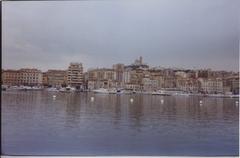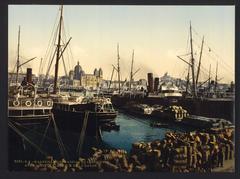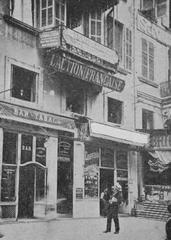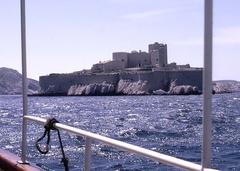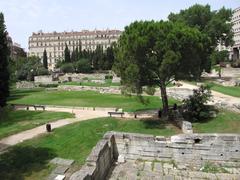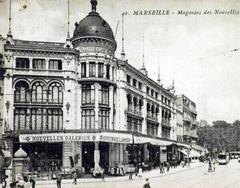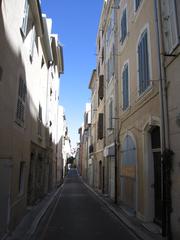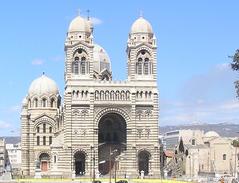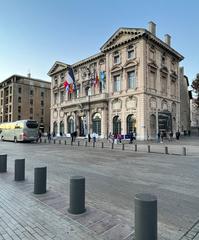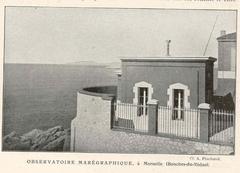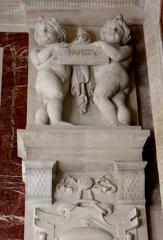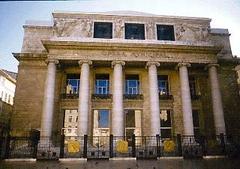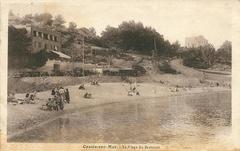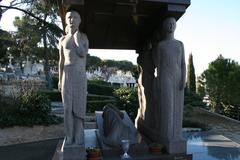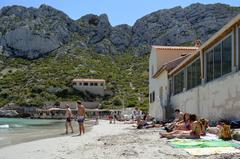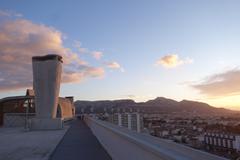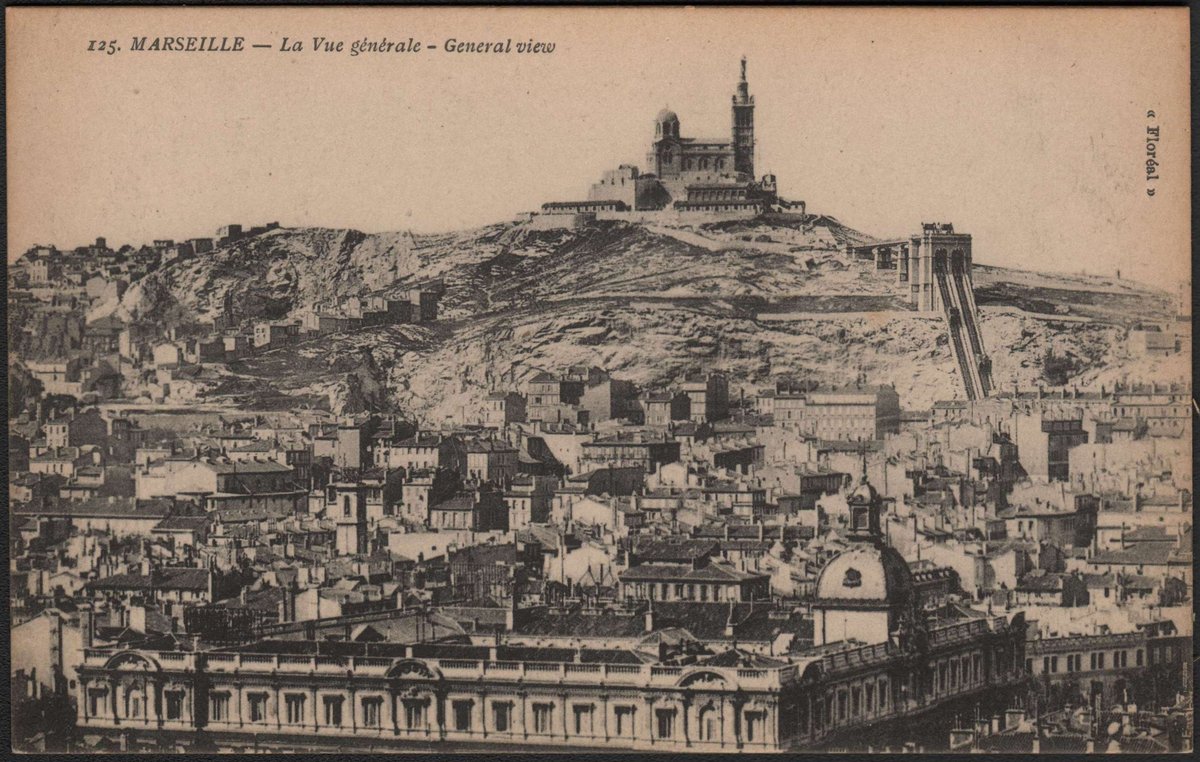
Comprehensive Guide to Visiting Basilique Notre-Dame de la Garde, Marseille, France
Date: 17/07/2024
Introduction
Nestled atop the highest natural point in Marseille, the Basilique Notre-Dame de la Garde stands as an enduring symbol of the city’s rich history, faith, and cultural heritage. Known affectionately as ‘La Bonne Mère’ (The Good Mother), this basilica has served as a beacon for sailors, a place of refuge during times of conflict, and a site of religious pilgrimage for centuries. Its strategic location offers panoramic views of Marseille and the Mediterranean Sea, making it a must-visit destination for both tourists and locals alike. This comprehensive guide will delve into the basilica’s fascinating history, its architectural marvels, and the practical information you need to make the most of your visit. Whether you’re drawn by its spiritual significance, its historical importance, or simply the breathtaking views, the Basilique Notre-Dame de la Garde promises an unforgettable experience. (Notre-Dame de la Garde)
Table of Contents
- Introduction
- History of Basilique Notre-Dame de la Garde
- Cultural and Religious Significance
- Visitor Information
- Nearby Attractions
- Special Events and Services
- FAQ
- Conclusion
History of Basilique Notre-Dame de la Garde
Early Beginnings
The site where the Basilique Notre-Dame de la Garde stands today has been a place of worship for centuries. The earliest recorded chapel on this hilltop dates back to 1214, built by a local priest named Master Pierre. This small sanctuary was dedicated to the Virgin Mary and quickly became a pilgrimage site for sailors and fishermen seeking protection and blessings before embarking on their voyages. The strategic location of the hill, offering panoramic views of the Mediterranean Sea, made it an ideal spot for both spiritual and practical purposes.
The 16th Century Fortifications
In the 16th century, the chapel’s significance grew, and it became necessary to fortify the site due to its strategic importance. In 1524, King Francis I of France ordered the construction of a fort around the chapel to protect Marseille from potential invasions. This fortification included a watchtower and artillery placements, transforming the hill into a military stronghold. Despite these changes, the chapel remained a place of worship, and its religious significance continued to attract pilgrims.
Construction of the Basilica
The current basilica was constructed between 1853 and 1864 under the direction of architect Henri-Jacques Espérandieu. The decision to build a new, grander church was driven by the growing number of pilgrims and the need for a more substantial structure to accommodate them. Espérandieu designed the basilica in the Romanesque-Byzantine style, characterized by its ornate mosaics, domes, and arches. The construction was funded by public donations, reflecting the deep devotion of the local community to the Virgin Mary.
Architectural Features
The Basilique Notre-Dame de la Garde is renowned for its stunning architectural features. The basilica’s exterior is adorned with alternating layers of white and green limestone, creating a striking visual effect. The bell tower, topped with a golden statue of the Virgin Mary holding the infant Jesus, stands at 41 meters (135 feet) tall and is visible from miles around. Inside, the basilica is decorated with intricate mosaics depicting scenes from the Bible and maritime motifs, paying homage to Marseille’s seafaring heritage.
Role During the World Wars
During both World War I and World War II, the basilica played a significant role in the lives of the people of Marseille. It served as a place of refuge and solace during times of conflict and uncertainty. The basilica’s strategic location also made it a target, and it suffered damage from bombings during World War II. Despite this, the basilica remained a symbol of hope and resilience for the local population.
Restoration and Preservation
In the years following World War II, extensive restoration work was carried out to repair the damage and preserve the basilica’s historical and architectural integrity. The most significant restoration project took place between 2001 and 2008, during which the mosaics, frescoes, and exterior stonework were meticulously restored. This project was funded by both public and private donations, highlighting the continued importance of the basilica to the people of Marseille.
Cultural and Religious Significance
Symbol of Protection
The basilica is affectionately known as “La Bonne Mère” (The Good Mother) and is considered the guardian of the city. This nickname reflects the deep cultural and emotional connection that the people of Marseille have with the basilica. It is believed that the Virgin Mary, represented by the statue atop the bell tower, watches over and protects the city and its inhabitants. This belief is so ingrained in local culture that sailors and fishermen often make offerings at the basilica before embarking on their voyages.
Pilgrimage and Festivals
Notre-Dame de la Garde is a major pilgrimage site, attracting thousands of visitors each year. The most significant pilgrimage occurs on August 15th, the Feast of the Assumption, when the faithful gather to honor the Virgin Mary. The basilica also hosts various religious festivals and processions throughout the year, which are integral to the cultural fabric of Marseille. These events often include traditional music, dance, and local cuisine, providing a rich cultural experience for both locals and tourists.
Artistic Contributions
The basilica is home to an impressive collection of ex-votos, which are offerings made in gratitude for divine intervention. These ex-votos include paintings, model ships, and plaques, many of which are displayed in the basilica’s museum. The collection provides a fascinating insight into the personal stories and historical events that have shaped the lives of the people of Marseille. Additionally, the basilica’s interior is adorned with intricate mosaics and frescoes, which are considered masterpieces of religious art.
Visitor Information
Tickets, Hours, and Accessibility
The Basilique Notre-Dame de la Garde is easily accessible from various parts of Marseille. Visitors can reach the basilica by car, public transportation, or on foot. A popular option is the Petit Train de Marseille, a tourist train that departs from the Old Port and takes visitors on a scenic route up to the basilica. For those who prefer to walk, a well-marked path leads up the hill, offering a rewarding hike with stunning views along the way.
The basilica is open to visitors year-round, with no admission fee. However, donations are welcome and help support the ongoing maintenance and preservation of the site. Guided tours are available for those interested in learning more about the basilica’s history, architecture, and cultural significance. Additionally, the basilica’s gift shop offers a range of religious souvenirs, books, and local products.
Opening Hours
The basilica is open daily from 7:00 AM to 7:00 PM. During the summer months, the closing time is extended to 8:00 PM.
Ticket Prices
Admission to the basilica is free, but donations are encouraged to help with its upkeep.
Guided Tours and Information
To enhance the visitor experience, Notre-Dame de la Garde offers guided tours in multiple languages. These tours provide in-depth information about the basilica’s history, architecture, and cultural significance. Visitors can also access informational brochures and audio guides, which are available at the entrance. The basilica’s website (Notre-Dame de la Garde) provides additional resources, including virtual tours and educational materials.
Photography Tips
The basilica offers numerous photographic opportunities, both inside and out. For the best shots, visit early in the morning or late in the afternoon when the light is soft. Don’t miss capturing the panoramic views of Marseille and the Mediterranean Sea from the basilica’s terrace.
Nearby Attractions
While visiting the Basilique Notre-Dame de la Garde, consider exploring other nearby attractions such as the Old Port of Marseille, the MuCEM (Museum of European and Mediterranean Civilisations), and the historic Le Panier district. These sites offer additional insights into the rich history and vibrant culture of Marseille.
Special Events and Services
Mass and Religious Services
The basilica holds regular masses and religious services. Visitors are welcome to attend, but it’s important to be respectful and follow the guidelines provided by the staff.
Concerts and Cultural Events
The basilica occasionally hosts concerts and cultural events. Check the official website or local listings for information on upcoming events during your visit.
FAQ
Q: What are the Basilique Notre-Dame de la Garde visiting hours?
A: The basilica is open daily from 7:00 AM to 7:00 PM, with extended hours until 8:00 PM during the summer months.
Q: How much are tickets to Basilique Notre-Dame de la Garde?
A: Admission to the basilica is free, but donations are welcomed to support maintenance and preservation efforts.
Q: How can I get to Basilique Notre-Dame de la Garde?
A: The basilica can be reached by car, public transportation, or on foot. The Petit Train de Marseille is a popular option for tourists.
Q: Are guided tours available at Basilique Notre-Dame de la Garde?
A: Yes, guided tours are available and provide detailed insights into the basilica’s history, architecture, and cultural significance.
Conclusion
The Basilique Notre-Dame de la Garde stands as a testament to the enduring faith and resilience of the people of Marseille. Its rich history, stunning architecture, and cultural significance make it a must-visit destination for anyone traveling to the city. Whether you are a pilgrim seeking spiritual solace or a tourist eager to explore Marseille’s heritage, the basilica offers a unique and unforgettable experience.
Stay Up to Date
For more information on visiting the Basilique Notre-Dame de la Garde and other historical sites in Marseille, be sure to follow our blog, download the Audiala app, and stay connected with us on social media. (Notre-Dame de la Garde, Marseille Tourism Office)
References
- Notre-Dame de la Garde https://www.notredamedelagarde.com
- Marseille Tourism Office https://www.marseille-tourisme.com

